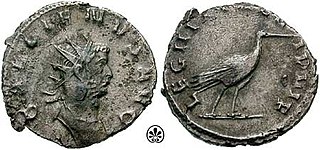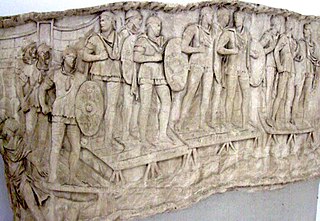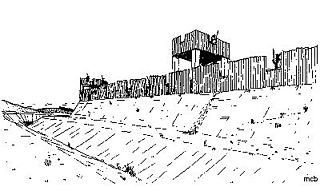
Legio III Italica was a legion of the Imperial Roman army founded in 165 AD by the emperor Marcus Aurelius for his campaign against the Marcomanni tribe. The cognomen Italica suggests that the legion's original recruits were drawn for the defence of Italy. The legion was still active in Raetia and other provinces in the early 5th century.
Lucius Neratius Marcellus was an imperial Roman military officer and senator who held a number of posts in the Emperor's service. Marcellus was elected consul twice, first under Domitian in 95 AD and again under Hadrian in 129. His life provides several examples of how patronage operated in early Imperial Rome.

Quintus Lollius Urbicus was a Berber governor of Roman Britain between the years 139 and 142, during the reign of the Emperor Antoninus Pius. He is named in the Historia Augusta, although it is not entirely historical, and his name appears on five Roman inscriptions from Britain; his career is set out in detail on a pair of inscriptions set up in his native Tiddis near Cirta, Numidia.
Marcus Statius Priscus Licinius Italicus was a Roman senator and general active during the reigns of Hadrian, Antoninus Pius, and Marcus Aurelius. Contemporary sources refer to him as Marcus Statius Priscus or simply Statius Priscus. He was consul for the year 159 as the colleague of Plautius Quintillus; Priscus was one of only two homines novi to attain the ordinary consul in the reigns of Antoninus Pius and Marcus Aurelius.

The auxilia were introduced as non-citizen troops attached to the citizen legions by Augustus after his reorganisation of the Imperial Roman army from 27 BC. By the 2nd century, the Auxilia contained the same number of infantry as the legions and, in addition, provided almost all of the Roman army's cavalry and more specialised troops. The auxilia thus represented three-fifths of Rome's regular land forces at that time. Like their legionary counterparts, auxiliary recruits were mostly volunteers, not conscripts.
The Vocontii were a Gallic people dwelling on the western foothills of the Alps during the Iron Age and the Roman period.

Concangis was an auxiliary castra in the Roman province of Lower Britain. Its ruins are located in Chester-le-Street, County Durham, in England, and are now known as Chester-le-Street Roman Fort. It is situated 6 miles (10 km) north of the city of Durham and 8 miles (13 km) south of Newcastle upon Tyne.
Cohors secunda Gallorum veterana equitata was a mixed infantry and cavalry regiment of the Auxilia corps of the Imperial Roman army. It was stationed, in the 2nd and 3rd centuries, in a fort near Hadrian's Wall in Britain.
Cohors quarta Gallorum equitata was a Roman auxiliary cohort containing both infantry and cavalry contingents.
Cohors prima Aquitanorum was a Roman auxiliary infantry regiment. It was probably originally raised in Gallia Aquitania in the reign of founder-emperor Augustus after the revolt of the Aquitani was suppressed in 26 BC. Unlike most Gauls, the Aquitani were not Celtic-speaking but spoke Aquitanian, a now extinct non Indo-European language closely related to Basque.
Cohors secunda Delmatarum was a Roman auxiliary infantry regiment.

Uxelodunum was a Roman fort with associated civilian settlement (vicus) in modern-day Carlisle, Cumbria, England. It was the largest fort on Hadrian's Wall and is now buried beneath the suburb of Stanwix.

The Batavi was an auxilia palatina (infantry) unit of the late Roman army, active between the 4th and the 5th century. It was composed by 500 soldiers and was the heir of those ethnic groups that were initially used as auxiliary units of the Roman army and later integrated in the Roman Empire after the Constitutio Antoniniana. Their name was derived from the people of the Batavi.
Sextus Catius Clementinus Priscillianus was a Roman military officer and senator who was appointed consul in AD 230.
Cohors PrimÆ Ælia Dacorvm was an infantry regiment of the Auxilia corps of the Imperial Roman army. It was first raised by the Roman emperor Hadrian in the Roman province of Dacia not later than AD 125 and its last surviving record dates c. 400. It was deployed, for virtually its entire history, in forts on Hadrian's Wall on the northern frontier of Britannia province.
Cohors [prima] Batavorum milliaria civium Romanorum pia fidelis was a Roman auxiliary cohort of infantry.
Cohors prima Ulpia Dacorum was an infantry regiment of the Auxilia corps of the Imperial Roman army. It was founded by the Roman emperor Trajan, probably in preparation for his planned war against Parthia (113-6). The regiment's honorific title Ulpia refers to the emperor's gens, or clan-name.

Cohors prima Flavia Canathenorum [sagittaria] [milliaria] was a Roman auxiliary cohort of infantry.
Cohors tertia Ulpia Petraeorum [sagittaria] [milliaria] [equitata] was a Roman auxiliary cohort of infantry and cavalry.
Cohors I Hamiorum sagittariorum was a Roman auxiliary infantry unit of archers raised near the ancient city of Hama, Syria. It was a cohors quingenaria consisting of 480 men. The unit's origins are unknown and it is unclear when the unit was first created; however, its existence can be definitively attested in the reign of Hadrian. Military diplomas from the years 122, 124, 127, and 135 AD show that the unit was stationed in Britannia at Magnis (Carvoran). It is the only regiment of archers known to be stationed in Britain. The unit was transferred to Caledonia sometime during the reign of Antoninus Pius according to three inscriptions found at the Bar Hill Fort on the Antonine Wall. In 163 or 164 AD, the regiment was transferred back to Carvoran.







